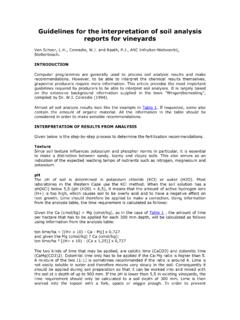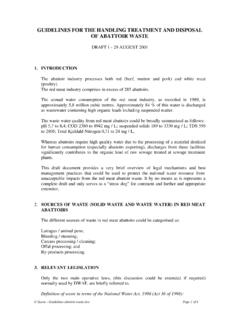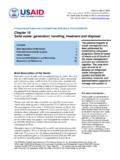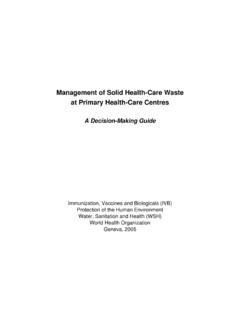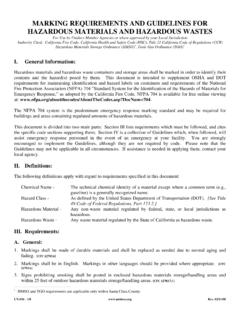Transcription of GUIDELINES FOR THE MANAGEMENT OF …
1 GUIDELINES FOR THE MANAGEMENT OF wastewater AND solid waste AT EXISTING WINERIES 2 GUIDELINES FOR THE MANAGEMENT OF wastewater AND solid waste AT EXISTING WINERIES Compiled by: van Schoor Enviroscientific & Winetech E-mail: Reviewed by: Booysen (Executive Manager: Winetech) G. Hofmann (Winetech) J. Rossouw (Dept. of Water Affairs and Forestry) M. Theron (Mynhardt Theron Consultancies & Winetech) J. Wooldridge (ARC Infruitec-Nietvoorbij) B. Schutte (Water and waste Utilisation Solutions) Approved by: Booysen (Executive Manager: Winetech) C. Theron (Winetech) J. Schreuder (Winetech) March 2005 This document is available in English and Afrikaans on the following websites 3 TABLE OF CONTENTS Glossary and Abbreviations 5 1.
2 Introduction 8 2. Potential environmental impacts 9 3. GUIDELINES for developing winery wastewater and solid waste MANAGEMENT plans at existing wineries 9 4. End use of winery wastewater 11 Introduction 11 Feasibility of wastewater irrigation 12 Legal requirements for winery wastewater irrigation and storage 13 Irrigation scheduling 16 General 16 Monthly water budget 16 Crop
3 Selection 17 5. Origin of winery wastewater and associated pollutants 18 General 18 Categories of winery wastewater 19 Characteristics of winery wastewater 20 6. GUIDELINES for monitoring wastewater volumes 21 7. GUIDELINES for constructing wastewater holding dams 22 8. GUIDELINES for wastewater sampling 22 9. Soil monitoring 24 410. GUIDELINES for cleaner production strategies 25 General 25 Reducing water pollution 25 Reducing water consumption 26 11.
4 Responsible handling of chemicals 26 12. Initial treatment of wastewater in holding dams 27 13. Higher technology treatment options 28 14. GUIDELINES for cleaning holding dams 29 15. GUIDELINES for solid waste MANAGEMENT 30 16. GUIDELINES for conducting an environmental risk assessment 31 17. GUIDELINES for staff training 33 18. Application for Authorisation from DWAF 33 Literature cited 34 Appendix 1: Winetech Environmental MANAGEMENT Research Results: CD outline Appendix 2: Example of Technical Summary of a Winery and Soil investigation 5 GLOSSARY AND ABBREVIATIONS BOD, Biological Oxygen Demand A measure of the amount of organic pollution that is present in water.
5 Measured as the amount of oxygen which is taken up from a sample containing a known amount of oxygen and maintained at 20 C for five days. Low BOD values indicate little pollution, whereas high BOD s indicate increased activity of heterotrophic micro organisms and therefore heavy pollution. BOD values in winery wastewater tend to be around 60 5 to 66% of the COD. Buffer zone Distance between the site of an activity and that of a neighbouring activity. COD, Chemical oxygen demand A measure of total organic content expressed in terms of the amount of oxygen required to bring about its destruction through oxidation. COD is used by the Department of Water Affairs and Forestry to monitor water quality for regulatory purposes.
6 Where pollution levels are high the COD may exceed the rate at which oxygen can reach the rate of consumption. This leads to depletion of the oxygen concentration of the water or soil. Low oxygen concentrations inhibit root growth and may give lead to the production of unpleasant odours. Composting The process by which organic material is converted to a stable end product (compost) by natural degradation is known as composting. The sustained high temperatures generated during effective composting kill most parasites, rendering the material relatively safe to handle. Composting is facilitated by the presence of oxygen and moisture. DE, Diatomaceous earth (Kieselguhr) Fine grained hydrated silica composed of the silicaceous cell walls of diatoms (unicellular, plankton algae).
7 Used as filter aid during winemaking. Deflocculation Separation of the individual components of a soil, commonly caused by changes in the electrolyte concentration and / or composition of the soil solution. It frequently occurs in soils which are characterised by low soluble salt concentrations (low electrolyte concentration) but with high exchangeable sodium percentages. Deflocculation leads to severe degradation in the physical condition of the soil and to increased susceptibility to erosion. DWAF The Department of Water Affairs and Forestry. EC, Electrical conductivity The EC of the wastewater is an indication of the concentration of dissolved salts in the water.
8 The greater the usage of salts by the winery, the higher the EC of the wastewater will be. EC is measured in milli Siemens per meter (mS/m). ESP, Exchangeable sodium percentage The percentage of the cation exchange capacity (CEC) of the soil (where CEC is expressed in cmol of charge/kg soil) that is occupied by sodium. ESP is calculated as follows: (amount of exchangeable sodium in cmolc/kg soil / (CEC in cmolc/kg soil) x 100. 6 Essential element A chemical element that is required for the normal growth of plants, without which plants cannot complete their lifecycle. Eutrophication The artificial or natural enrichment of a river, dam or lake by influx of those nutrients which enhance the growth and spread of aquatic plants.)
9 Feacal Coliforms The presence of faecal coliform bacteria indicates that faecal pollution is taking place. Faecal coliform counts in polluted water range from 100 to 100 000 bacteria per 100 ml. A count of 20 000 / 100 ml is considered to be high, and indicates that unacceptable amounts of human or animal waste are entering the water prior to irrigation. The faecal coliform count should always be measured in order that remedial measures, such as the application of quaternary ammonia, may be prescribed where necessary. IPW, Integrated production of Wine A scheme which was developed to ensure the environmentally friendly production of wine in South Africa. The essence of this scheme is the implementation of MANAGEMENT plans in which are integrated the latest information and technology concerning sustainability, conservation and the protection of biodiversity (see ).
10 The IPW scheme was promulgated under the Act on Liquor Products, and fully supports Act 108 of 1996, Article 24, which concerns constitutional aims regarding environmental health and the conservation of the environment for future generations. Leaching The removal of soluble constituents ( salts and nutrients) from the soil by water moving through the soil profile. Lees Winery fermentation sediment (yeasts, tartrates and pulp). Marc (grape solids) The stalks, pips and skins which remain behind after the grapes have been crushed and pressed. Grape solids are sometimes referred to as marc in international literature. mS/m or milli Siemens per meter See EC pH The degree of acidity or alkalinity, defined as the negative log (base 10) of the hydrogen ion activity in water (or in a soil extract or suspension).

